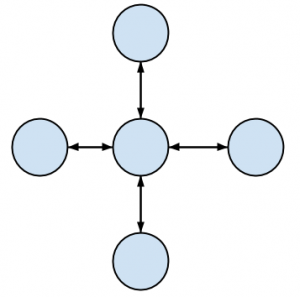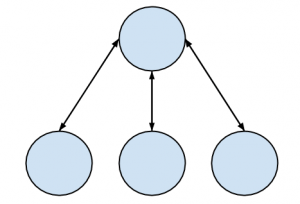This set of Cloud Computing Multiple Choice Questions & Answers (MCQs) focuses on “Business Process Modeling – 1”.
1. Which of the following architecture is shown in the following figure?
| Service Oriented Modelling practice |
| Modelling Environments |
| Modelling Solutions |
| Best Practices |
a) SOMF 2.0
b) SOMF 4.0
c) SOMF 3.5
d) None of the mentioned
View Answer
Explanation: A service in SOMF that is granular and very narrow in scope is referred to as an atomic service.
2. Point out the correct statement.
a) The service object is a container where the service resides
b) The port or endpoint is the unique address of the service
c) The message content is the data and metadata that the service operation is performed on
d) All of the mentioned
View Answer
Explanation: Each message may consist of one or more parts, and each part must include typing information.
3. Which of the following is the language standard for Web service interactions?
a) WS-BPEL
b) WS-XML
c) WS-JSON
d) All of the mentioned
View Answer
Explanation: BPEL is a meta-language comprised of two functions.
4. Which of the following messaging protocol is used with XML in BPEL?
a) WS-Coordination
b) WS-Addressing
c) WS-Transactions
d) All of the mentioned
View Answer
Explanation: BPEL uses XML with specific support for messaging protocols.
5. Point out the wrong statement.
a) XML schema cannot be separate files
b) A WSDL file contains essential message data for a transaction
c) A service contract codifies the relationship between the data to be processed and also the metadata that accompanies that data
d) None of the mentioned
View Answer
Explanation: The XML document sets up the namespace, defines the interface, specifies the binding, names the service, provides the documentation for the service, and then supplies a schema that may be used to validate the document.
6. Which of the following topology is shown in the following figure?

a) Circular
b) Star
c) Hierarchical
d) All of the mentioned
View Answer
Explanation: In star topology, every node (computer workstation or any other peripheral) is connected to a central node called a hub or switch.
7. Which of the following statement is incorrect related to BPEL?
a) Data functions in BPEL support process data and control flow
b) BPEL includes techniques for error handling and scopes transactions
c) BPEL uses Web services for standards and to assemble and decompose processes
d) None of the mentioned
View Answer
Explanation: BPEL does not have a graphical component.
8. _______ is a methodology for representing business processes as a set of connected visual objects.
a) BPNM
b) BPMN
c) BPMM
d) BPNN
View Answer
Explanation: BPMN stands for Business Process Modeling Notation.
9. Which of the following system models creates a graphical representation of software systems in the form of a set of diagram types?
a) SysML
b) UML
c) XMI
d) None of the mentioned
View Answer
Explanation: UML is widely used in the industry for software system modeling.
10. Which of the following topology is shown in the following figure?

a) Circular
b) Star
c) Hierarchical
d) Network
View Answer
Explanation: Hierarchical network models are iterative algorithms for creating networks which are able to reproduce the unique properties of the scale-free topology and the high clustering of the nodes at the same time.
Sanfoundry Global Education & Learning Series – Cloud Computing.
Here’s the list of Best Books in Cloud Computing.
To practice all areas of Cloud Computing, Here is complete set of 1000+ Multiple Choice Questions and Answers.
If you find a mistake in question / option / answer, kindly take a screenshot and email to [email protected]
- Practice MCA MCQs
- Practice Computer Science MCQs
- Apply for Computer Science Internship
- Check Cloud Computing Books
- Practice Information Science MCQs
